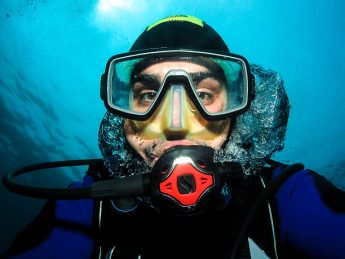Introduction
Quick Navigation
A Scuba Regulator, also called a Dive Regulator, is a significant equipment that controls a diver’s breathing gas pressure. It provides a connection between a diver and the gas in the cylinder so that underwater breathing is safe and easy. Due to the nature of the environment, this regulator reduces the pressure in the gas to maintain equality with the water’s ambient pressure.
What are the Parts of a Scuba Regulator?
While you understand how important a scuba regulator is to a diver, you should also make yourself aware of the different parts of this equipment. If you know a dive regulator’s parts, it shouldn’t be difficult to keep up maintenance. Without anyone’s help, you can tell if a part needs fixing, or not – or better still, if the regulator needs replacement.
There are 5 parts to a scuba regulator; each has a role to play in efficiency and effectiveness. They include First Stage, Second Stage, Gauge Console, Low-Pressure Inflator Hose, and Alternate Stage.
First Stage
A scuba regulator’s first part is the pressure tank connection. It is called the “First Stage” because it is the stage that involves safety, i.e., the release of pressurized air from the tank. With the connection, a diver is provided with intermediate pressure air, which travels through low-pressure hoses.
Second Stage
The second part is conversion and acceptance. The intermediate pressure air provided to a diver through the hose is transformed into ambient pressure for safe use. Ambient pressure is the surrounding or environment pressure, i.e., water. The Second Stage is, however, connected to the mouthpiece for acceptance.
Gauge Console
The next scuba regulator part is the Gauge Console. It is also known as the Submersible Pressure Gauge because it describes the remaining pressure in a pressurized air tank. It is somewhat like a monitor to help a diver know what is available and take safety precautions.
Low-Pressure Inflator Hose
Before a diver starts, there is something called a Buoyancy Compensator (BC) that receives additional air. This additional air will compensate a diver when he gets too deep or exhausts what is available. However, what provides this compensational air is the Low-Pressure Inflator Hose. It is a connector between the First Stage and BC.
Alternate Second Stage
The Second Stage has an extra part – the Alternate Second Stage. It also ensures proper breathing underwater – a mouthpiece designed for a second diver. The alternate second stage may not be found in most scuba diving regulators, but it is always useful during emergencies.
How a Scuba Dive Regulator Really Works?
With a proper understanding of the various parts of a scuba dive regulator, it shouldn’t be difficult explaining the working operation.
On how a scuba regulator works, there isn’t much to it.
First, you need to realize that as you go deeper underwater, water pressure changes – the more the depths, the higher the pressure. It is important to regulate this pressure so that you can breathe safely.
Ideally, there are only limits to how humans can breathe under pressure. High pressure can result in to passing out or even death.
However, a scuba regulator has a First Stage to help convert the air in the pressurized air tank to an intermediate pressure air. The high-pressure air in the tank is often about 300 psi, which is quite dangerous and uncomfortable. On conversion to intermediate air, it reduces to 140 psi.
However, this air is converted further to the water’s pressure through the low-pressure inflator hose in the Second Stage. On delivery, through the mouthpiece, you can breathe just fine, and it doesn’t matter the depths you go.
Therefore, the entire operation of a scuba regulator depends on the First Stage, Second Stage, and Low-Pressure Inflator Hose. Other parts such as the Alternate Second Stage, Gauge Console, Valves, Piston, Diaphragm, and Purge Buttons, are only to ensure safety and excellent monitoring.
How to Maintain a Scuba Regulator?
Taking care and investing in the maintenance of your scuba regulator is essential. If you don’t want to keep on spending on new regulators that will only last for a while, you need to do a few things before and after diving.
First, rinse your regulator a few hours before diving in fresh warm, or tap water. It is a way of preventing corrosion and removing materials for effective use.
Also, you should dust the cap before it gets on the First Stage. A dirty or damaged cap can affect the quality of breathing because the air provided is compromised. However, you shouldn’t make the mistake of soaking the First Stage because it is not waterproof.
Furthermore, soak regulator parts like the Gauge Console, Low-Pressure Inflate Hose, and Second Stages for a few minutes. You should also clean the mouthpiece thoroughly. Finally, leave these parts out in the sun to dry before storing or using the regulator.
Conclusion
If you are inexperienced in the diving world, you should most likely be curious about how a scuba regulator works. Not to worry, this article has done so much to put vital pieces of information out to help you understand how it does. While you know the various parts of this diving equipment, you should also take good care of it against damages.

